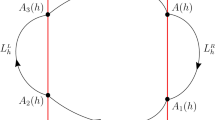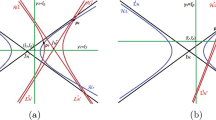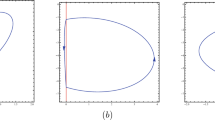Abstract
We obtain lower bounds for the maximum number of limit cycles bifurcating from periodic annuli of discontinuous planar piecewise linear Hamiltonian differential systems with three zones separated by two parallel straight lines, assuming that the linear differential subsystem in the region between the two straight lines, called of central subsystem, has a saddle at a point equidistant from these lines. (Obviously, the other subsystems have saddles or centers.) We prove that at least six limit cycles bifurcate from the periodic annuli of these kind of piecewise Hamiltonian differential systems, by linear perturbations. Normal forms and Melnikov functions, defined in two and three zones, are the main techniques used in the proof of the results.







Similar content being viewed by others
Data Availability
The datasets generated during and/or analyzed during the current study are available from the corresponding author on reasonable request.
References
Braga, D.C., Mello, L.F.: Limit cycles in a family of discontinuous piecewise linear differential systems with two zones in the plane. Nonlin. Dyn. 73, 1283–1288 (2013). https://doi.org/10.1007/s11071-013-0862-3
Buzzi, C.A., Pessoa, C., Torregrosa, J.: Piecewise linear perturbations of a linear center. Discrete Contin. Dyn. Syst. 33, 3915–3936 (2013). https://doi.org/10.3934/dcds.2013.33.3915
Carmona, V., Fernández-Sánchez, F., Novaes, D.D.: Uniform upper bound for the number of limit cycles of planar piecewise linear differential systems with two zones separated by a straight line. Appl. Math. Lett. 137, 108501, 8 (2023). https://doi.org/10.1016/j.aml.2022.108501
Carmona, V., Fernández-Sánchez, F., Novaes, D.D.: A new simple proof for Lum–Chua’s conjecture. Nonlinear Anal. Hybrid Syst. 40, 100992, 7 (2021). https://doi.org/10.1016/j.nahs.2020.100992
Coombes, S.: Neuronal networks with gap junctions: a study of piecewise linear planar neuron models. SIAM Appl. Dyn. Syst. 7, 1101–1129 (2008). https://doi.org/10.1137/070707579
Corinto, F., Ascoli, A., Gilli, M.: Nonlinear dynamics of memristor oscillators. IEEE Trans. Circuits Syst. I. Regul. Pap. 58, 1323–1336 (2011). https://doi.org/10.1109/TCSI.2010.2097731
Chua, L.O., Lin, G.: Canonical realization of Chua’s circuit family. IEEE Trans. Circuits Syst. 37, 885–902 (1990). https://doi.org/10.1109/31.55064
di Bernardo, M., Budd, C.J., Champneys, A.R., Kowalczyk, P.: Piecewise-Smooth Dynamical Systems: Theory and Applications. Springer (2008)
Dong, G., Liu, C.: Note on limit cycles for m-piecewise discontinuous polynomial Liénard differential equations. Z. Angew. Math. Phys. 68, 97 (2017). https://doi.org/10.1007/s00033-017-0844-2
FitzHugh, R.: Impulses and physiological states in theoretical models of nerve membrane. Biophys. J. 1, 445–466 (1961). https://doi.org/10.1016/S0006-3495(61)86902-6
Fonseca, A.F., Llibre, J., Mello, L.F.: Limit cycles in planar piecewise linear Hamiltonian systems with three zones without equilibrium points. Int. J. Bifur. Chaos Appl. Sci. Eng. 30, 205018 (2020). https://doi.org/10.1142/S0218127420501576
Freire, E., Ponce, E., Rodrigo, F., Torres, F.: Bifurcation sets of continuous piecewise linear systems with two zones. Int. J. Bifur. Chaos Appl. Sci. Eng. 8, 2073–2097 (1998). https://doi.org/10.1142/S0218127498001728
Freire, E., Ponce, E., Torres, F.: Canonical discontinuous planar piecewise linear systems. SIAM J. Appl. Dyn. Syst. 11, 181–211 (2012). https://doi.org/10.1137/11083928X
Freire, E., Ponce, E., Torres, F.: The discontinuous matching of two planar linear foci can have three nested crossing limit cycles. Publ. Mat. 2014, 221–253 (2014)
Henson, M., Seborg, D.: Nonlinear Process Control. Prentice Hall PTR, Upper Saddle River (1997)
Hilbert, D.: Mathematical problems, M. Newton. Trans. Bull. Am. Math. Soc. 8, 437–479 (1902). https://doi.org/10.1090/S0002-9904-1902-00923-3
Hu, N., Du, Z.: Bifurcation of periodic orbits emanated from a vertex in discontinuous planar systems. Commun. Nonlinear Sci. Numer. Simulat. 18, 3436–3448 (2013). https://doi.org/10.1016/j.cnsns.2013.05.012
Huan, S.M., Yang, X.S.: On the number of limit cycles in general planar piecewise linear systems. Discrete Contin. Dyn. Syst. 32(6), 2147–2164 (2012). https://doi.org/10.3934/dcds.2012.32.2147
Li, L.: Three crossing limit cycles in planar piecewise linear systems with saddle focus type. Electron. J. Qual. Theory Differ. Equ. 70, 1–14 (2014). https://doi.org/10.14232/ejqtde.2014.1.70
Li, Z., Liu, X.: Limit cycles in the discontinuous planar piecewise linear systems with three zones. Qual. Theory Dyn. Syst. 20, 79 (2021). https://doi.org/10.1007/s12346-021-00496-4
Lima, M., Pessoa, C., Pereira, W.: Limit cycles bifurcating from a period annulus in continuous piecewise linear differential systems with three zones. Int. J. Bifur. Chaos Appl. Sci. Eng. 27, 1750022, 14 (2017). https://doi.org/10.1142/S0218127417500225
Liu, X., Han, M.: Bifurcation of limit cycles by perturbing piecewise Hamiltonian systems. Int. J. Bifur. Chaos Appl. Sci. Eng. 5, 1–12 (2010). https://doi.org/10.1142/S021812741002654X
Llibre, J., Novaes, D., Teixeira, M.A.: On the birth of limit cycles for non-smooth dynamical systems. Bull. Sci. Math. 139, 229–244 (2012). https://doi.org/10.1016/j.bulsci.2014.08.011
Llibre, J., Novaes, D., Teixeira, M.A.: Maximum number of limit cycles for certain piecewise linear dynamical systems. Nonlin. Dyn. 82, 1159–1175 (2015). https://doi.org/10.1007/s11071-015-2223-x
Llibre, J., Ponce, E.: Three nested limit cycles in discontinuous piecewise linear differential systems with two zones. Dyn. Contin. Discrete Impuls Syst. Ser. B Appl. Algorithms 19(3), 325–335 (2012)
Llibre, J., Ponce, E., Valls, C.: Uniqueness and non-uniqueness of limit cycles for piecewise linear differential systems with three zones and no symmetry. J. Nonlin. Sci. 25, 861–887 (2015). https://doi.org/10.1007/s00332-015-9244-y
Llibre, J., Teixeira, M.A.: Limit cycles for m-piecewise discontinuous polynomial Liénard differential equations. Z. Angew. Math. Phys. 66, 51–66 (2015). https://doi.org/10.1007/s00033-013-0393-2
Llibre, J., Teixeira, M.A.: Piecewise linear differential systems with only centers can create limit cycles? Nonlin. Dyn. 91, 249–255 (2018). https://doi.org/10.1007/s11071-017-3866-6
Llibre, J., Teruel, E.: Introduction to the Qualitative Theory of Differential Systems; Planar, Symmetric and Continuous Piecewise Linear Systems. Birkhauser (2014)
McKean, H.P., Jr.: Nagumo’s equation. Adv. Math. 4, 209–223 (1970). https://doi.org/10.1016/0001-8708(70)90023-X
Nagumo, J.S., Arimoto, S., Yoshizawa, S.: An active pulse transmission line simulating nerve axon. Proc. IRE 50, 2061–2071 (1962). https://doi.org/10.1109/JRPROC.1962.288235
Narendra, K.: Frequency Domain Criteria for Absolute Stability. Elsevier (2014)
Ponce, E., Ros, J., Vela, E.: The boundary focus-saddle bifurcation in planar piecewise linear systems. Application to the analysis of memristor oscillators. Nonlinear Anal. Real World Appl. 43, 495–514 (2018). https://doi.org/10.1016/j.nonrwa.2018.03.011
Pessoa, C., Ribeiro, R.: Limit cycles bifurcating from a periodic annulus in discontinuous planar piecewise linear Hamiltonian differential system with three zones. Int. J. Bifur. Chaos Appl. Sci. Eng. 32, 2250114, 16 (2022). https://doi.org/10.1142/S0218127422501140
Pessoa, C., Ribeiro, R.: Persistence of periodic solutions from discontinuous planar piecewise linear Hamiltonian differential systems with three zones. São Paulo J. Math. Sci. (2022). https://doi.org/10.1007/s40863-022-00313-z
Pontryagin, L.S.: Ordinary Differential Equations. Addison-Wesley, Reading (1962)
Thul, R., Coombes, S.: Understanding cardiac alternans: a piecewise linear modeling framework. Chaos 20, 045102, 13 (2010). https://doi.org/10.1063/1.3518362
Tonnelier, A., Gerstner, W.: Piecewise linear differential equations and integrateand-fire neurons: insights from two-dimensional membrane models. Phys. Rev. E 67, 021908 16 (2003). https://doi.org/10.1103/PhysRevE.67.021908
Wang, Y., Han, M., Constantinesn, D.: On the limit cycles of perturbed discontinuous planar systems with 4 switching lines. Chaos Soliton Fract. 83, 158–177 (2016). https://doi.org/10.1016/j.chaos.2015.11.041
Wang, J., Huang, C., Huang, L.: Discontinuity induced limit cycles in a general planar piecewise linear system of saddle-focus type. Nonlin. Anal. Hybrid Syst. 33, 162–178 (2019). https://doi.org/10.1016/j.nahs.2019.03.004
Xiong, Y., Han, M.: Limit cycle bifurcations in discontinuous planar systems with multiple lines. J. Appl. Anal. Comput 10, 361–377 (2020). https://doi.org/10.11948/20190274
Xiong, Y., Wang, C.: Limit cycle bifurcations of planar piecewise differential systems with three zones. Nonlin. Anal. Real World Appl. 61, 103333, 18 (2021). https://doi.org/10.1016/j.nonrwa.2021.103333
Yang, J.: On the number of limit cycles by perturbing a piecewise smooth Hamilton system with two straight lines of separation. J. Appl. Anal. Comput. 6, 2362–2380 (2020). https://doi.org/10.11948/20190220
Zhang, X., Xiong, Y., Zhang, Y.: The number of limit cycles by perturbing a piecewise linear system with three zones. Commun. Pure Appl. Anal. 5, 1833–1855 (2022). https://doi.org/10.3934/cpaa.2022049
Acknowledgements
The first author is partially supported by São Paulo Research Foundation (FAPESP) grant 2023/04061-6. The first, third and fourth authors are also supported by FAPESP grant 2019/10269-3. The second author was supported by Brazilian Federal Agency for Support and Evaluation of Graduate Education (CAPES) grant 88882.434343/2019-01. The third author is partially supported by FAPESP grants 2022/09633-5 and 2018/13481-0 and by National Council for Scientific and Technological Development (CNPq) grants 438975/2018-9 and 309110/2021-1. The fourth author is also partially supported by FAPESP grant 2022/04040-6. The fifth author is partially supported by Pronex/FAPEG/CNPq grant 2017 10 26 7000 508 CAPES grant 88881.068462/2014-01 and CNPq grants 402060/2022-9 and 308652/2022-3. Moreover, this article was possible thanks to the scholarship granted from the CAPES, in the scope of the Program CAPES-Print, process number 88887.310463/2018-00, International Cooperation Project number 88881.310741/2018-01.
Author information
Authors and Affiliations
Corresponding author
Ethics declarations
Conflict of interest
The authors have no conflict of interest.
Ethical standard
All procedures performed in studies involving human participants were in accordance with the ethical standards of the institutional and/or national research committee and with the 1964 Helsinki Declaration and its later amendments or comparable ethical standards.
Human and animal rights
This article does not contain any studies with animals performed by any of the authors.
Informed consent
Informed consent was obtained from all individual participants included in the study.
Additional information
Publisher's Note
Springer Nature remains neutral with regard to jurisdictional claims in published maps and institutional affiliations.
Appendices
Appendix A
The coefficients list of the Melnikov functions for the case CSS is the following:
Appendix B
The coefficients list of the Melnikov functions for the case CSC is the following:
Conclusion
In this paper, we study the number and position of crossing limit cycles of discontinuous planar piecewise linear Hamiltonian differential systems with three zones separated by two parallel straight lines, assuming that the linear differential subsystem have a saddle in the central one. By estimating the number of simultaneous simple zeros of the first-order Melnikov functions associated with the piecewise near-Hamiltonian differential systems, we prove that at least six crossing limit cycles can bifurcate from the periodic annuli of these kind of piecewise systems, after affine linear perturbations.
Rights and permissions
Springer Nature or its licensor (e.g. a society or other partner) holds exclusive rights to this article under a publishing agreement with the author(s) or other rightsholder(s); author self-archiving of the accepted manuscript version of this article is solely governed by the terms of such publishing agreement and applicable law.
About this article
Cite this article
Pessoa, C., Ribeiro, R., Novaes, D. et al. On cyclicity in discontinuous piecewise linear near-Hamiltonian differential systems with three zones having a saddle in the central one. Nonlinear Dyn 111, 21153–21175 (2023). https://doi.org/10.1007/s11071-023-08931-8
Received:
Accepted:
Published:
Issue Date:
DOI: https://doi.org/10.1007/s11071-023-08931-8




